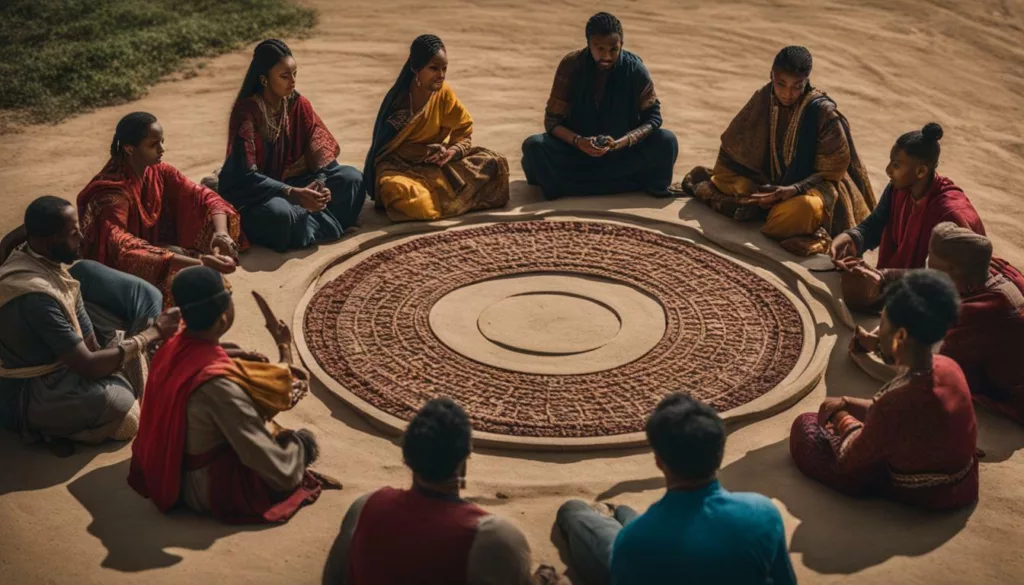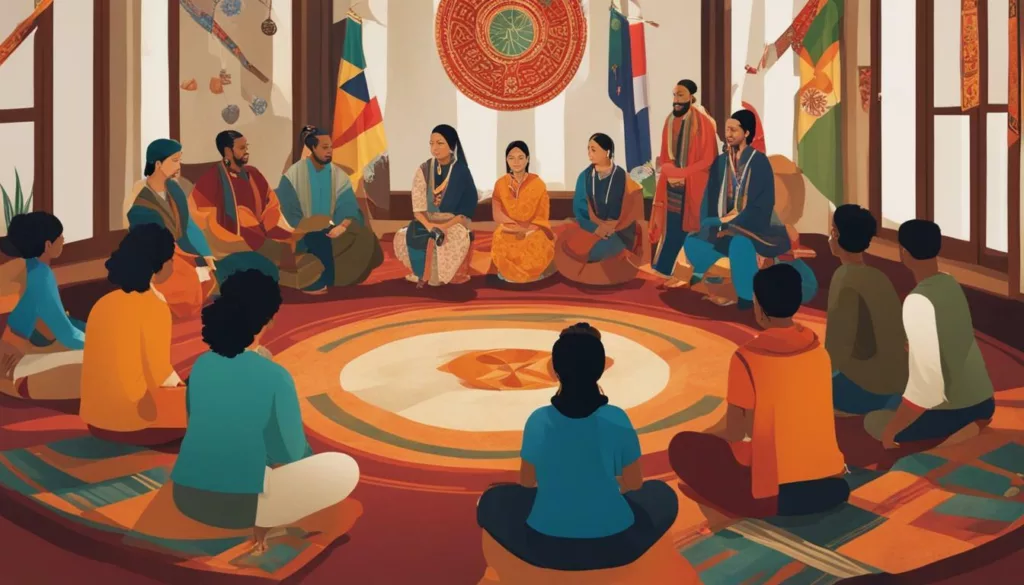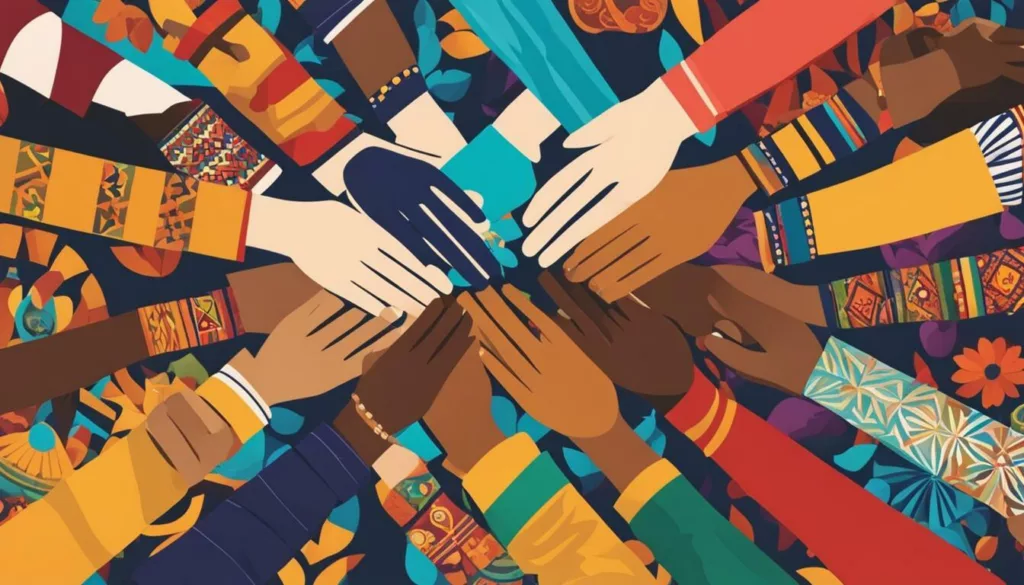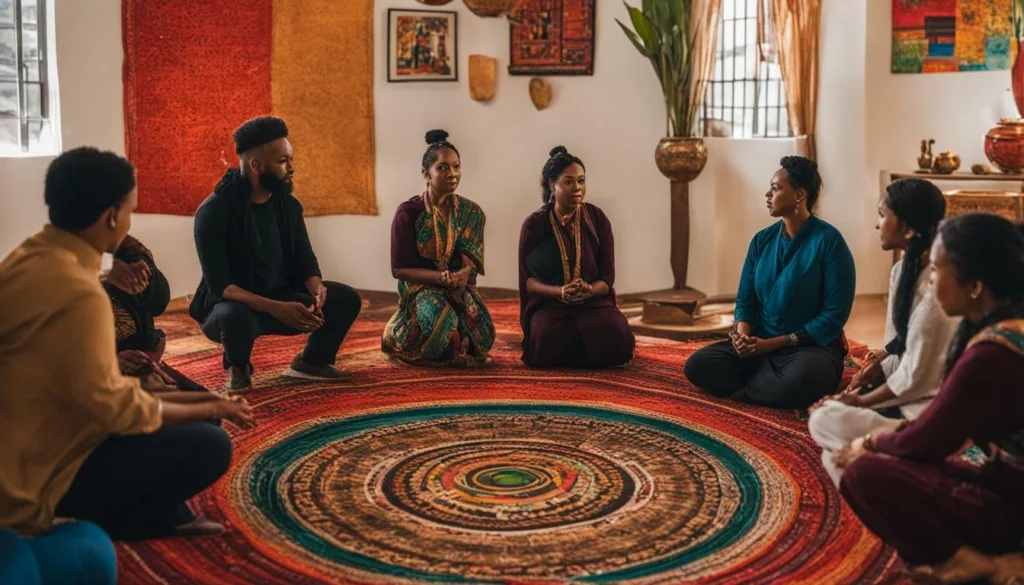A Respectful Approach: Navigating Cultural Sensitivities in Manifestation
Welcome to a discussion on the crucial role of cultural sensitivities in manifestation and how it influences our perception of reality. In today’s diverse world, it is essential to approach manifestation with respect for cultural differences and foster inclusivity. Cultural diversity in manifestation enriches our experiences and allows us to learn from different perspectives.
- Cultural sensitivities play a critical role in manifestation.
- Understanding and respecting cultural differences is vital for effective communication in manifestation.
- Strategies for navigating communication across cultures include active listening, adapting communication styles, and building relationships.
- Cultivating cultural sensitivity through workshops and training programs enhances manifestation skills.
- Self-awareness and cultural awareness are essential in improving communication with cultural differences.
Embarking on a journey of manifestation requires us to embrace cultural sensitivities with open hearts and minds. By navigating these sensitivities respectfully, we can foster understanding, collaboration, and stronger relationships. Let’s continue to celebrate cultural diversity and create a more inclusive manifestation experience for all.
Understanding Cultural Differences in Manifestation
To navigate cultural sensitivities in manifestation, it is essential to have a deep understanding of cultural differences and be aware of how they impact our interactions. Communication plays a crucial role, and challenges arise when trying to communicate across cultures due to language barriers, differences in communication styles, and cultural biases.
Language barriers can hinder effective communication, as words may have different meanings or may not exist in another language. This can lead to misunderstandings and misinterpretations. Additionally, differences in communication styles, such as direct versus indirect communication, can also affect how messages are perceived.
Cultural biases can shape our perceptions and behaviors, leading to assumptions and misunderstandings. It is important to recognize and challenge these biases to foster open-mindedness and cultural awareness. By understanding cultural differences, we can adapt our communication styles, actively listen, and show respect for cultural customs.

Awareness of cultural norms and sensitivities allows for more inclusive and respectful interactions. Building relationships based on respect and understanding can help bridge cultural gaps and foster collaboration. By embracing different perspectives, we can grow personally and collectively, enriching our manifestations and creating a more harmonious and diverse environment.
| Key Challenges | Strategies for Navigating Communication |
|---|---|
| Language barriers |
|
| Differences in communication styles |
|
| Cultural biases |
|
Successful communication across cultures requires the implementation of effective strategies that foster understanding and respect. Navigating the complexities of cultural differences can be challenging, but with the right approach, it can lead to stronger relationships and collaboration.
One important strategy is to be open-minded. Approaching conversations with a willingness to learn and understand different perspectives is key in building bridges between cultures. It allows us to embrace diversity and appreciate the richness it brings to our manifestations.
Practicing active listening is another crucial aspect of effective communication. By genuinely listening to others without judgment or assumptions, we create a safe space for open dialogue and mutual understanding. This encourages individuals from different cultures to share their thoughts and ideas, fostering a collaborative and inclusive environment.
Adapting communication styles is also essential in bridging cultural gaps. Different cultures have unique ways of expressing themselves, and adapting our communication to align with their norms can help avoid misunderstandings. This may involve adjusting our tone, gestures, and even choice of words to ensure clarity and respect.
| Cultural Sensitivity Examples | Cultural Competence Training |
|---|---|
| Respecting personal space in conversations | Learning about cultural values and customs |
| Avoiding sensitive topics | Developing empathy and understanding |
| Using appropriate greetings and titles | Recognizing and challenging personal biases |
Building relationships based on respect and cultural awareness is also crucial. Taking the time to learn about each other’s cultural backgrounds, customs, and traditions helps foster mutual trust and appreciation. It shows that we value diversity and are committed to creating a harmonious environment for manifestation.
By following these strategies and embracing cultural sensitivity training, we can navigate communication across cultures effectively. It allows us to build bridges, enhance collaboration, and create a more inclusive manifestation process. Let us strive to understand, respect, and celebrate our differences, as they are a powerful catalyst for growth and success.

Cultivating cultural sensitivity is a key aspect of manifesting a more inclusive and harmonious world. It requires a deep understanding and respect for cultural norms, as well as a willingness to learn and adapt in order to effectively communicate and collaborate across cultures.
One way to develop cultural sensitivity is through participation in cultural sensitivity workshops and training programs. These initiatives provide individuals with the knowledge, skills, and tools necessary to navigate the complexities of communication with cultural differences. They offer a safe space for individuals to explore and discuss cultural biases, stereotypes, and preconceived notions that may hinder effective communication. Through interactive activities, role-playing exercises, and discussions, participants gain a deeper understanding of their own cultural background and biases, as well as those of others.
During these workshops, participants learn strategies for building strong relationships based on respect and understanding. They are encouraged to be open-minded and actively listen to others, allowing for a more inclusive and collaborative environment. Participants also learn to adapt their communication styles to better suit the cultural preferences and expectations of their counterparts. By showing respect for cultural customs, traditions, and values, individuals can foster mutual respect and create stronger connections across cultures.
| Cultural Sensitivity Workshops Benefits |
|---|
| Enhanced communication skills across cultures |
| Deeper understanding and appreciation of cultural diversity |
| Reduced misunderstandings and conflicts |
| Increased collaboration and teamwork |
By investing in cultural sensitivity workshops and training programs, individuals and organizations can create a more inclusive and understanding environment. This not only enhances personal and professional relationships but also contributes to the overall growth and prosperity of our global society.

- Developing cultural sensitivity is essential for manifesting inclusivity and harmony.
- Cultural sensitivity workshops and training programs provide the necessary knowledge and skills to navigate communication with cultural differences.
- Strategies such as active listening, adapting communication styles, and showing respect for cultural customs promote understanding and collaboration.
- Cultural sensitivity workshops offer benefits such as enhanced communication skills, appreciation of diversity, reduced conflicts, and increased collaboration.
The Role of Self-Awareness and Cultural Awareness
Developing self-awareness and cultural awareness is fundamental to effectively engage with cultural differences and foster meaningful connections. When navigating communication across cultures, it is crucial to recognize and understand the impact of our own cultural lens on our perceptions and interactions. This awareness allows us to approach conversations with humility, curiosity, and an open mind.
One way to develop self-awareness is by actively learning about other cultures. Taking the time to educate ourselves about different customs, traditions, and communication styles can help us navigate conversations more effectively. Additionally, being mindful of nonverbal cues, such as body language and facial expressions, enables us to better interpret and respond to the messages being conveyed.
Cultural sensitivity is essential in promoting inclusive and respectful communication. It involves respecting and valuing diverse perspectives and actively working to avoid misunderstandings. Patience plays a key role in this process, as it allows us to take the time to listen, understand, and seek clarification when needed. By embracing different perspectives, we create an environment that encourages growth and fosters stronger relationships.
As we continue to engage with cultural differences in manifestation, let us remember the importance of self-awareness and cultural awareness. By acknowledging and embracing the richness that cultural diversity brings, we can create a more inclusive and harmonious world.

Building strong and inclusive relationships is vital for manifesting a world that values and embraces cultural diversity. Navigating communication with cultural differences requires respect and understanding of cultural norms. Challenges in communication across cultures include language barriers, differences in communication styles, and cultural biases. But by adopting strategies that promote understanding and collaboration, we can overcome these challenges and forge meaningful connections.
One of the key strategies for building strong relationships across cultures is being open-minded. By approaching interactions with a willingness to learn and understand different perspectives, we create an environment that fosters growth and inclusivity. It’s important to remember that cultural differences can influence communication styles, so active listening becomes crucial in bridging gaps. By truly listening and seeking to understand, we can build trust and create a space where all voices are valued.
Adapting Communication Styles
Adapting communication styles is another important aspect of building inclusive relationships. Recognizing that cultural norms can shape how individuals express themselves allows us to tailor our own communication approach. This means being aware of differences in verbal and nonverbal cues, adapting our language and tone, and respecting cultural customs. By doing so, we show our willingness to meet others where they are and create a sense of belonging.
Effective communication across cultures promotes understanding, collaboration, and stronger relationships.
Building relationships with cultural awareness requires an investment in learning about other cultures. Taking the time to educate ourselves on different customs, traditions, and values allows us to navigate conversations with sensitivity and empathy. It’s important to be mindful of nonverbal cues, as gestures and body language can vary across cultures. This awareness helps us avoid misunderstandings and enhances our ability to connect on a deeper level.

| Strategies | Description |
|---|---|
| Be open-minded | Approach interactions with a willingness to learn and understand different perspectives |
| Practice active listening | Truly listen and seek to understand, bridging the gaps in communication |
| Adapt communication styles | Be aware of differences in verbal and nonverbal cues, and tailor your communication approach accordingly |
| Respect cultural customs | Show appreciation for and understanding of cultural practices |
By building strong and inclusive relationships, we not only enhance our manifestation journey but also contribute to a world that celebrates cultural diversity. Through respect, understanding, and cultural awareness, we can create a more harmonious and connected society.
Embracing Different Perspectives for Growth
Embracing different perspectives empowers us to grow personally and collectively in the realm of cultural sensitivities in manifestation. Navigating communication with cultural differences requires respect and understanding of cultural norms. Challenges in communication across cultures include language barriers, differences in communication styles, and cultural biases. It is essential to approach these challenges with an open mind and a willingness to learn from others.
Active listening is a key strategy for effective communication across cultures. By actively listening to others’ perspectives and experiences, we can gain valuable insights that broaden our understanding. This not only strengthens our relationships but also fosters an environment of respect and inclusivity. We must adapt our communication styles to suit different cultural contexts, ensuring that we are sensitive to cultural customs and norms.
Self-awareness and cultural awareness play crucial roles in improving communication skills with cultural differences. Actively seeking to learn about other cultures and being mindful of nonverbal cues can help avoid misunderstandings. It is essential to approach cultural differences with patience and a genuine curiosity to understand diverse viewpoints. By doing so, we create an environment that encourages collaboration and mutual growth.

In conclusion, navigating cultural sensitivities in manifestation requires a conscious effort to embrace different perspectives. By practicing active listening, adapting our communication styles, and fostering self-awareness and cultural awareness, we can build stronger relationships and promote inclusivity. Let us continue to cultivate a mindset of respect, understanding, and openness as we navigate the diverse cultural landscape of manifestation.
Conclusion
In conclusion, navigating cultural sensitivities in manifestation requires a respectful approach, understanding of cultural differences, effective communication strategies, and a commitment to building inclusive relationships. It is important to recognize and respect the cultural norms and values of others, as well as to be aware of our own biases and perspectives.
Challenges in communication across cultures can arise from language barriers, differences in communication styles, and cultural biases. However, by being open-minded, practicing active listening, and adapting our communication styles, we can bridge these gaps and foster understanding.
Building strong and inclusive relationships is essential in navigating cultural sensitivities in manifestation. By showing respect for cultural customs, cultivating cultural sensitivity, and embracing different perspectives, we can create an environment that values diversity and promotes collaboration.
Ultimately, improving communication skills with cultural differences requires self-awareness and cultural awareness. Actively learning about other cultures and being mindful of nonverbal cues can help us avoid misunderstandings and foster stronger connections.
Let us continue our journey towards a more inclusive world through the power of manifestation, where we celebrate cultural diversity, foster understanding, and promote respect for all.
FAQ
A: Navigating communication with cultural differences requires respect and understanding of cultural norms. It is important to be open-minded, practice active listening, adapt communication styles, build relationships, and show respect for cultural customs.
Q: What are the challenges in communication across cultures?
A: Challenges in communication across cultures include language barriers, differences in communication styles, and cultural biases. It is important to be aware of these challenges and approach them with understanding.
Q: How can I improve my communication skills with cultural differences?
A: Improving communication skills with cultural differences involves self-awareness and cultural awareness. Actively learning about other cultures and being mindful of nonverbal cues can help avoid misunderstandings. It is important to be patient, ask for clarification, and be open to different perspectives.






